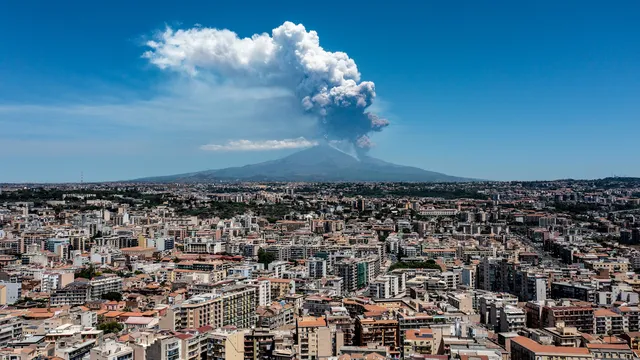
Mount Etna erupts, sending tourists fleeing from Italy's volcano
2025-06-04 12:44- Mount Etna erupted early in the morning on June 2, 2025, sending ash and smoke into the air.
- Tourists rushed down the slopes amid increasing volcanic activity and a red aviation alert was issued.
- Authorities continue to monitor the situation as this eruption highlights the ongoing risk of living near such an active volcano.
Express your sentiment!
Insights
On June 2, 2025, Mount Etna, located on the east coast of Sicily, Italy, erupted, resulting in an extensive display of volcanic activity that included the emission of a significant plume of ash and smoke. The eruption commenced around 3.50 AM local time, following a series of volcanic tremors that had started at midnight. The National Institute of Geophysics and Volcanology reported that the eruption was characterized by strong strombolian explosions and increasing intensity of activity, leading to concerns regarding potential hazards to nearby communities and tourists. The Volcanic Ash Advisory Centre in Toulouse raised a red aviation alert due to a volcanic ash plume reaching 6,400 meters in altitude, although flight operations remained largely unaffected by midday. Eyewitness accounts noted that tourists were seen fleeing down the slopes of the volcano as the eruption progressed, illustrating the urgency of the situation. A pyroclastic flow, described as an avalanche of hot rock, ash, and gas, was also noted during the eruption, although it did not extend beyond a designated safe area known as the Valley of the Lion. This eruption is part of an ongoing trend of volcanic activity at Mount Etna, which is one of the world's most active volcanoes. The region, populated by numerous residents who have settled on the fertile slopes of the volcano, is perennially at risk, given the dynamic nature of Etna. As part of travel safety measures, the UK's Foreign, Commonwealth and Development Office advised potential travelers to adhere to local safety protocols, including immediate evacuation if instructed, along with safeguarding essential documents and supplies. Reports indicated that around 20% of Sicily's population resides in areas adjacent to Mount Etna, which highlights both the allure and risks associated with living in proximity to such an active geological feature. The previous months leading up to this eruption had already seen multiple eruptions, with significant outpourings of ash and lava that attracted tourists and scientists alike. Historically, Mount Etna has a long history of eruptions, with notable activity occurring every few months, reinforcing its status as a subject of study and fascination. Local authorities continue to monitor the situation closely, evaluating geological data to assess the evolving risk for both residents and tourists in the region. Preparedness and awareness are critical components in ensuring safety amidst the awe-inspiring but hazardous activity of Mount Etna.
Contexts
Mount Etna, one of the most active volcanoes in the world, is located on the east coast of Sicily, Italy. Its historical eruptions date back to ancient times, with recorded activity spanning over 2,500 years. The volcano is characterized by its frequent eruptions, which vary in style and intensity, including effusive eruptions, where lava flows are predominant, and explosive events, producing ash clouds and pyroclastic flows. Mount Etna's eruptions can be traced back to around 1500 BCE, highlighted in historical texts by Greek and Roman scholars who documented various eruptions and their impacts on nearby communities. The eruption history of Mount Etna is marked by significant events that have shaped both its geological structure and the surrounding environment. Notable eruptions include a series of powerful explosive eruptions during the 1669 eruption, which destroyed the town of Catania and altered the landscape dramatically. The 1928 eruption was another major event that led to the destruction of multiple villages and prompted extensive study of volcanic activity. Scientists consider Mount Etna an open laboratory for understanding volcanic processes due to its frequent eruptions and the accessibility of the area for research. In modern history, Mount Etna has continued to display its dynamic nature, with eruptions that can affect air traffic and pose risks to local populations. The 2001 eruption was noted for its lava fountains and was closely monitored due to its proximity to populated areas. More recently, in 2021, a series of eruptions produced impressive lava flows and ash emissions, sparking interest among volcanologists and tourists alike. Such events underscore the need for monitoring and hazard assessment in regions surrounding the volcano, as eruptions can result in both local and far-reaching consequences due to the dispersal of volcanic ash and gases. The ongoing research and monitoring of Mount Etna contribute significantly to the understanding of volcanic activity. Institutions such as the Italian National Institute of Geophysics and Volcanology actively study the volcano's behavior, employing advanced technology and data analysis to predict eruptions. This research is crucial for ensuring public safety and mitigating the impacts of volcanic eruptions on the local economy and infrastructure. Given the persistent activity of Mount Etna, the volcano remains a vital subject for scientific investigation, providing essential insights into the processes that govern one of nature's most powerful phenomena.